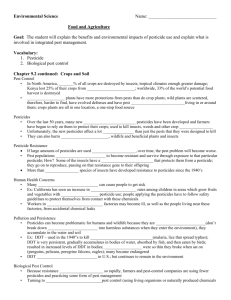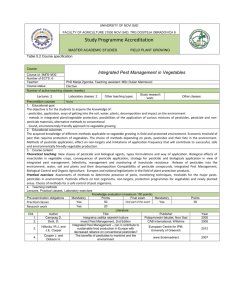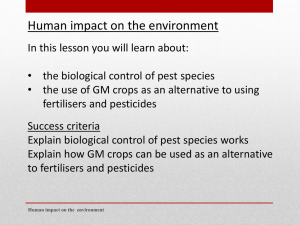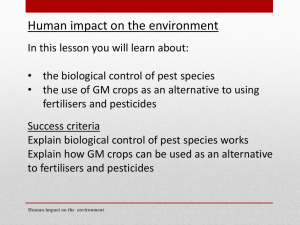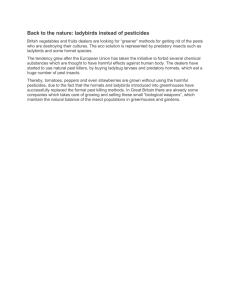Environmental Science Name: Food and Agriculture Goal: The
advertisement
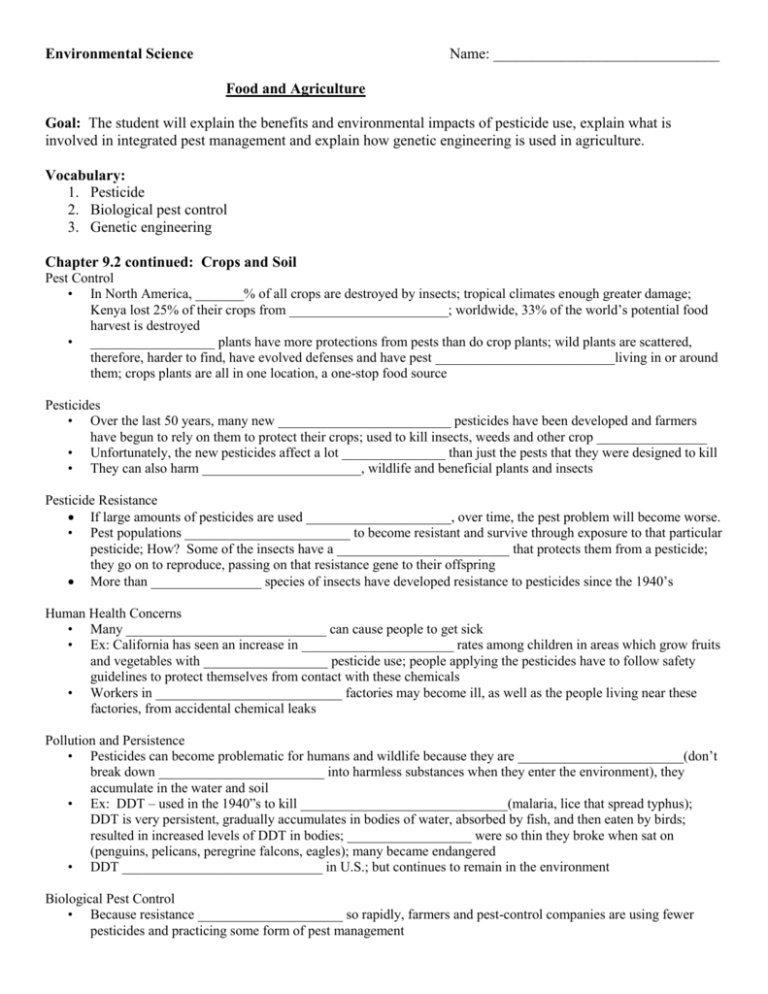
Environmental Science Name: ______________________________ Food and Agriculture Goal: The student will explain the benefits and environmental impacts of pesticide use, explain what is involved in integrated pest management and explain how genetic engineering is used in agriculture. Vocabulary: 1. Pesticide 2. Biological pest control 3. Genetic engineering Chapter 9.2 continued: Crops and Soil Pest Control • In North America, _______% of all crops are destroyed by insects; tropical climates enough greater damage; Kenya lost 25% of their crops from _______________________; worldwide, 33% of the world’s potential food harvest is destroyed • __________________ plants have more protections from pests than do crop plants; wild plants are scattered, therefore, harder to find, have evolved defenses and have pest __________________________living in or around them; crops plants are all in one location, a one-stop food source Pesticides • Over the last 50 years, many new _________________________ pesticides have been developed and farmers have begun to rely on them to protect their crops; used to kill insects, weeds and other crop ________________ • Unfortunately, the new pesticides affect a lot _______________ than just the pests that they were designed to kill • They can also harm _______________________, wildlife and beneficial plants and insects Pesticide Resistance If large amounts of pesticides are used _____________________, over time, the pest problem will become worse. • Pest populations ________________________ to become resistant and survive through exposure to that particular pesticide; How? Some of the insects have a _________________________ that protects them from a pesticide; they go on to reproduce, passing on that resistance gene to their offspring More than ________________ species of insects have developed resistance to pesticides since the 1940’s Human Health Concerns • Many _____________________________ can cause people to get sick • Ex: California has seen an increase in ______________________ rates among children in areas which grow fruits and vegetables with __________________ pesticide use; people applying the pesticides have to follow safety guidelines to protect themselves from contact with these chemicals • Workers in ___________________________ factories may become ill, as well as the people living near these factories, from accidental chemical leaks Pollution and Persistence • Pesticides can become problematic for humans and wildlife because they are ________________________(don’t break down ________________________ into harmless substances when they enter the environment), they accumulate in the water and soil • Ex: DDT – used in the 1940”s to kill ______________________________(malaria, lice that spread typhus); DDT is very persistent, gradually accumulates in bodies of water, absorbed by fish, and then eaten by birds; resulted in increased levels of DDT in bodies; __________________ were so thin they broke when sat on (penguins, pelicans, peregrine falcons, eagles); many became endangered • DDT _____________________________ in U.S.; but continues to remain in the environment Biological Pest Control • Because resistance _____________________ so rapidly, farmers and pest-control companies are using fewer pesticides and practicing some form of pest management • • Turning to ___________________________pest control (using living organisms or naturally produced chemicals to control pests); every pests has enemies in the wild and those enemies can be used to __________________ pest populations (ex: In India (mid-1800’s), American prickly pear cactus had been introduced into India to feed insects that are used to make a valuable ______________dye; Cactus had no natural enemies, grew and spread. Plants were finally controlled by the introduction of an American beetle that eats cactus Generally, do no ____________________anything but the particular pest it is designed to control, resistance takes longer to evolve Pathogens • Releasing a natural ________________________ or parasite is one method of biological control • _________________________ (organisms causing disease) is another method • Ex: Bacillus thuringensis (bacterium) kills larvae (caterpillars of moths and butterflies) Plant Defenses • Cross breeding some plant varieties to produce crops that have their own __________________________ • Tomato plants labeled “VNT” means they are resistant to certain fungi, worms and viruses • Ex: production of chemical compounds that _____________________________pests; tougher skin Chemicals From Plants • Another type of biological pest control is to make use of plants’ ______________________ chemicals (Ex: extracting chemicals from the chrysanthemum and sell it as a pesticide) • They are ______________________________________________ (can be broken down by bacteria and other decomposers) and are designed for use in the home because they do not harm humans or pets Disrupting Insect Breeding • Growth _____________________________ are chemicals that interfere with some stage of a pest’s life cycle (ex: dogs – flea pills prevent flea eggs from developing) • _____________________ - chemicals produced by an organism that affect the behavior of another - are also used • Ex: female moths find mates by releasing pheromones that ______________________ males, farmers treat crops with those pheromones to ____________________________ the males (interferes with mating) • Another example: treat male insects with ___________________________, making them sterile; when they mate, eggs do not get fertilized Integrated Pest Management This is a ____________________________ method of controlling pests on crops (see handout) Not designed to ______________________________ pest populations but to reduce pest damage to a level that causes minimal economic damage; program is designed for ______________________________ crops; can include a _______________ of farming methods (biological pest control and chemical pest control) Used at specific times in the _________________________ season, fields are monitored at all times during the growing season, when significant pest damage is found, pest is identified and program to control the ______________ is created Biological methods are the ________________________ methods used to control the pest (natural predators, pathogens, parasites of the pest) Cultivation controls can also be used As a _________________ resort, insecticide may be used; changed over time so they do not have the ability to evolve resistance Engineering a Better Crop Plant breeding has been used since ________________________________ began; farmers select best tasting tomato plants, ___________________ pest damage, save seeds and use them the next year; consequently, these plants are more likely have _____________________for large, tasty tomatoes and resist pest A faster way to get the same result is to use genetic engineering (genetic material in a living cell is modified for medical or industrial use); they will ______________________________genes from one organism and implant it into another to get the desirable trait they are looking for (ex: pest resistant) Plants resulting from _________________________ engineering are called genetically modified plants (GM) (See handout for steps used to produce a GM plant) Implications of Genetic Engineering In US, we now _________________ and use genetically engineered agricultural products every day Many have ___________________ been fully tested for environmental impacts; could cause problems in the future (ex: genes are sometimes transferred from one species to another in the wild) GM corn plant could pass its genes to a wild corn plant; then, that corn plant could _________________ be eliminated by a pesticide Sustainable Agriculture • How can we ______________________ the world’s population without depleting the world’s resources? • Low-input farming – farming _______________________ using a lot of energy, pesticides, fertilizers and water • Ex: ___________________ farming – farming without the use of synthetic materials, use manure, compost and keep the land planted at all times (reducing erosion), alternating crops • Aquaculture – “____________ farming” or raising fish in artificial environments Lesson Reflection: - YouTube Video: The Eyes of Nye – Genetically Modified Foods (25 min) w/Handout Assessment: 1. Define the term pest. 2. Describe how biological pest control is part of integrated pest management. 3. Describe how genetic engineering is used in agriculture. Active Reading: Crops and Soil Lesson Extension (Technology/Application/Connection to Real World): Compare the benefits and environmental impact of pesticide use.


